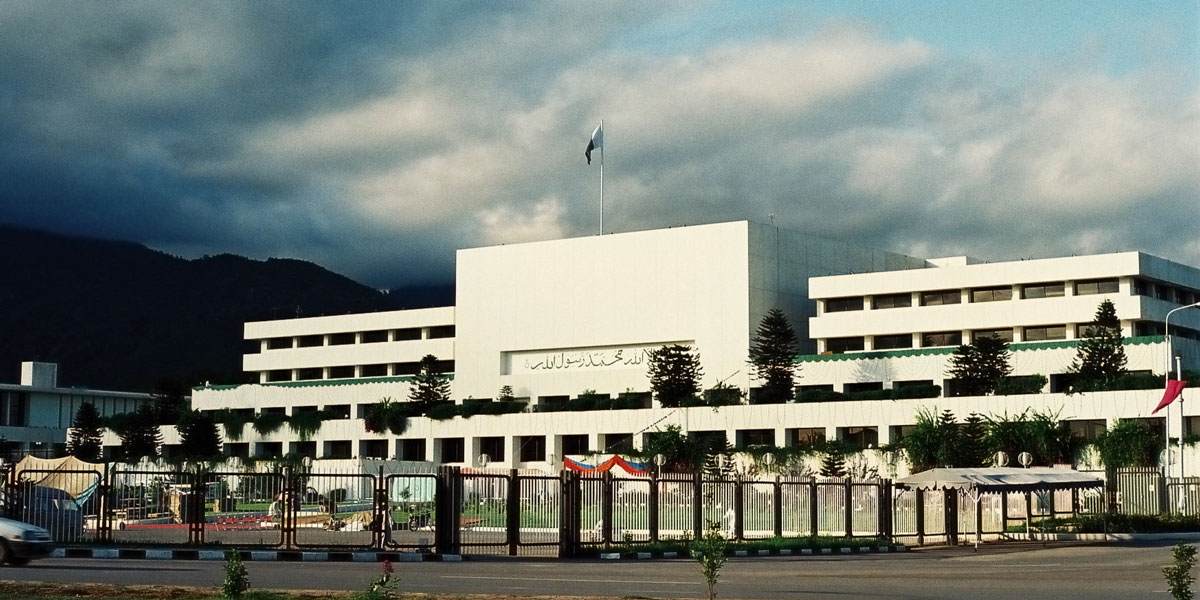Pakistan’s Finance Minister Muhammad Aurangzeb presented the 2024-25 federal budget of PKR 18.87 trillion (USD 68 billion) in the National Assembly yesterday, 12 June, 2024. This year’s national budget is an increase of 40% from the current 2023-24 fiscal year.
The 2024-25 budget has ambitious revenue targets. According to analysts, it is “in line with IMF guidelines.” Pakistan is negotiating with the IMF for a loan ranging from USD 6 to 8 billion to avoid a default in its sluggishly growing economy.
Pakistan’s budget for the upcoming year targets a modest 3.6% GDP growth and sets an ambitious PKR 13 trillion tax collection goal. To achieve this, taxes on salaried individuals will increase, and tax exemptions for others will be removed.
During the budget presentation, Aurangzeb emphasised that the objective is to broaden the tax base, thereby alleviating the burden on current taxpayers.
Budget highlights
- Total expenditure is estimated at PKR 18.9 trillion.
- An ambitious tax revenue target of PKR 13 trillion.
- Non-tax revenue target stands at PKR 3.5 trillion.
- Aims to generate Rs 30 billion from privatisation.
- Anticipates debt servicing costs of PKR 9.8 trillion.
- Targets a GDP growth of 3.6% for 2024-25.
- The budget deficit is projected at 6.9% of GDP.
- BISP allocation increased by 27% to PKR 592 billion.
Key tax policy measures
- Broaden the tax base to improve the tax-to-GDP ratio.
- Digitise the economy to enhance documentation.
- Implement a progressive taxation system to generate more taxes from high earners.
- Raise transaction taxes for non-filers.
- Shield vulnerable segments from the effects of inflation.
Overall budget allocation
The 2024-25 fiscal year budget has a total outlay of PKR 18.877 trillion, which includes both expenditures and net lending of funds. This is a 30% increase from the previous year’s budget.
Current expenditure
The government proposed a PKR 17,203 billion for current expenditures, which is a 29% increase from the previous year.
Debt serving or interest payments have increased to 34% (PKR 9,775 billion). This is the single biggest government expense, constituting over 50% of the total budget allocation.
Defence spending
Defence spending has remained largely unchanged, in terms of GDP, compared to the previous year. In the 2024-25 budget, defence spending has also seen a 17.6% increase from last year’s allocation totaling around PKR 2,122 billion or 1.71% of GDP.
Federal revenue
Pakistan’s total revenue for the fiscal year 2025 is projected at PKR 17,815 billion. After accounting for provincial transfers of PKR 7,438 billion, the net revenue stands at PKR 10,377 billion, which is a substantial 48.7% increase from the previous year.
In efforts to diminish its fiscal deficit, Pakistan has sought ways to boost revenue as part of ongoing reforms with the IMF. The increased tax target comprises a 48% rise in direct taxes and a 35% hike in indirect taxes. Additionally, non-tax revenue, including petroleum levies, is anticipated to surge by 64%.
The finance minister also proposed increasing sales taxes on certain products to boost government revenue. The sales tax on textile, leather products, and mobile phones will be raised to 18%. Aurangzeb also revealed increasing capital gains tax from real estate.
Privatisation revenue
Aurangzeb plans to generate PKR 30 billion from privatisation schemes by selling loss-making enterprises, starting with the national airline.
Bids for the airline will be invited in August.
Aurangzeb also indicated that no one will be exempt from paying due taxes in the upcoming FY2024-25. He also emphasised the need to reform the revenue system, energy sector, and state-owned enterprises (SOEs).
FBR’s ambitious tax target
The Federal Board of Revenue (FBR) has an ambitious tax collection target of PKR 12,970 billion, which is a 38% increase from last year’s target set by the government.
“The Prime Minister is closely monitoring the digitalisation of tax policies and FBR’s administrative reforms. Our goal is to broaden the tax net without burdening existing taxpayers,” Aurangzeb said.
Analysts, such as Mohammad Sohail, believe the tax collection target is high, but not impossible. “We believe that considering new taxation measures, Pakistan may be able to reach closer to the primary and fiscal deficit estimates,” he said.
Public Sector Development Programme (PSDP) allocation
The government has proposed an allocation of PKR 3,792.2 billion for the Public Sector Development Programme (PSDP) for the 2025 fiscal year, which is a 40% increase from last year’s PKR 2,709 billion.
The total federal PSDP, which includes state-owned enterprises and public-private partnerships, has surged to PKR 1,696 billion, marking a 47.5% increase from last year’s PKR 1,150 billion.
The provincial PSDP allocation has grown by 34.4%, reaching PKR 2,095 billion compared to PKR 1,559 billion in the previous year.
Inflation
Since May 2022, Pakistan has been grappling with inflation rates exceeding 20%. In May of last year, inflation soared to 38% amidst the country’s efforts to implement reforms under an IMF bailout programme.
Inflation has since shown signs of slowing down.
Aurangzeb emphasised that his government’s top priority was to address inflation. The government has established an inflation target of 12% for the next fiscal year to control prices.
“Inflation had surged to 38% a year ago, with food inflation reaching 48%, causing hardships for low-income households. I’m pleased to report that our improved economic strategy has successfully brought inflation down,” said Aurangzeb.
“In May 2024, the Consumer Price Index stood at 11.8% and food inflation at 2.2%. We’ve worked tirelessly to bring inflation into single digits and will sustain our efforts to ensure price stability,” he added.
Faisal Mamsa, Chief Executive of Tresmark, said to Dawn that inflation projections of 12% are achievable. “This can imply an average policy rate of 16%,” he said.
“The budget has a significant increase in tax burden this year,” said Vaqar Ahmed of Sustainable Development Policy Institute think-tank, adding, due to the large informal segment of the economy, the burden will fall on the existing sectors.
“The tax burden will have an inflationary impact as well,” he added.
Central Bank warns of inflationary effects
Pakistan’s central bank cautioned about potential inflationary effects from the budget, noting that there weren’t significant policy reforms to broaden the tax base that would result in increased revenue from higher taxes.
To stimulate growth, the bank cut interest rates by 150 basis points for the first time in four years, in response to a significant drop in inflation – from a peak of 38% in 2023 to 11.8% in May this year.
However, despite the government’s targets to increase revenues by 30% and stabilisation of the fiscal and current account deficits, the GDP is expected to grow by only 2.4% this year, which is short of the targeted 3.5% in the 2024-25 budget.
Agricultural sector propelled Pakistan’s GDP
Pakistan’s economy fell short of most targets set in the previous budget due to challenging conditions. However, Aurangzeb said the agriculture sector achieved unprecedented growth.
According to the Pakistan Economic Survey (PES) 2023-24, the agricultural sector has reported a robust 6.25% expansion, the highest in 19 years.
PES reported that the agricultural sector propelled Pakistan’s GDP growth to an anticipated 2.38% for FY2024, which is a recovery from the previous year’s contraction of 0.21%.
However, it also observed a decline in the investment-to-GDP ratio, lacklustre large-scale manufacturing, and high public debt.
Additionally, it revealed that Pakistan experienced the highest-ever single-year increase in tax exemptions, surging by 73.24%, when compared to the previous year, reaching a record PKR 3.879 trillion.















